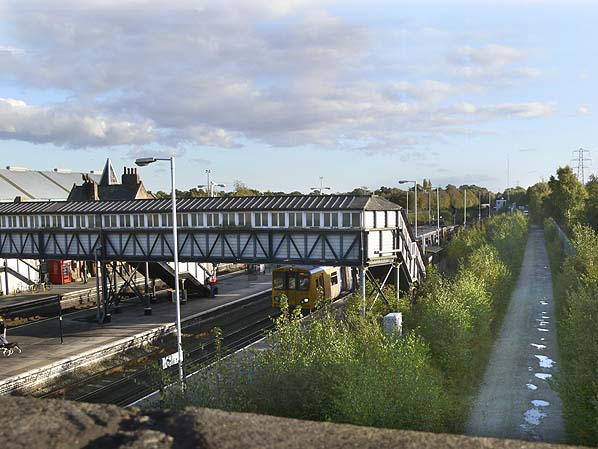
Station Name: HOOTON
|
| Date opened: | 23.4.1840 |
| Location: | South side of Hooton Road |
| Company on opening: | Chester and Birkenhead Railway |
| Date closed to passengers: | Still open |
| Date closed completely: | Still open |
| Company on closing: | Still open |
| Present state: | West Kirby branch platforms and waiting room are still extant. |
| County: | Cheshire |
| OS Grid Ref: | SJ349783 |
| Date of visit: | 8.10.2009 |
Notes: Following the widening of the Birkenhead Joint Railway (GWR/LNWR) to four tracks between Rock Ferry and Ledsham in 1900 Hooton Station, which had opened with the line in 1848, was rebuilt. The rebuilt station was provided with seven platforms. Platforms 6 and 7 where used by trains running along the Joint Railway companies West Kirby branch.
On the 1st October 1866 another branch, this time heading west from a point just to the South of Hooton station was opened to Parkgate. Most trains operating on the Parkgate branch terminated at Hooton. It is likely that a bay platform was provided for this service. On the 19th April 1886 the Parkgate Branch was extended to West Kirby. Most trains from this branch still terminated at Hooton. By 1886 express trains were running between Birkenhead Woodside Station and London Paddington and London Euston. The GWR running to Paddington and the LNWR to Euston. Many of these express services stopped at Hooton so that passengers travelling from the branch lines could make connections.
By the end of the 19th century the line between Birkenhead and Chester was so busy that there was a pressing need to provide extra capacity. The solution was to provide an extra two lines between Rock Ferry and Ledsham. By so doing two fast lines were created for express services and two slow lines for goods trains and local stopping passenger services. Hooton Station had to be completely rebuilt.
Platform 2 served the Up Fast line (towards Chester) whilst 3 served the Down Fast line (Towards Birkenhead). Platform 4 served the Up Slow line (Towards Chester) and 5 the Down Slow Line (Towards Birkenhead). Platform 6 was used by through trains running to West Kirby whilst 7 was used by through trains running from the West Kirby Branch towards Birkenhead. Both platforms 6 and 7 could be used by terminating trains from the West Kirby branch. The bay platform, number 1 was used by local services starting from and finishing at Hooton. Typically trains from Warrington or Helsby used the bay platform. In 1923 the Joint Line’s became GWR and London Midland Scottish Railway (LMS). Both companies operated their own services on the main line and on the West Kirby branch.
On the 17th September 1956 Passenger Services on the West Kirby Branch were withdrawn and all of the remaining passenger stations from Hooton to West Kirby closed. The very last passenger train left West Kirby at 9:55pm and terminated at Hooton.
On the 5th November 1967 Hooton Station lost its main line train services when Birkenhead Woodside Station closed. All that remained was a DMU service from Chester to Rock Ferry and from Helsby to Rock Ferry. At Rock Ferry a connection could be made with the former electric Mersey Railway that ran via a tunnel under the Mersey to Liverpool Central. In 1969 the line from Rock Ferry to Ledsham reverted to being double track but at Hooton station four tracks remained. In the early 1970s the Wirral Country Park opened. It started at Hooton station and ran along the branch to West Kirby. The former Platform 7 became part of the Country Park. Throughout the 1970s the DMU service continued to serve Hooton but in the early 1980s plans were made for an extension of the electrified former Mersey Railway, which had become by then the Merseyrail Wirral Line from Rock Ferry to Hooton.
Further plans were drawn up at this time to continue the electrification through to Chester and to Ellesmere Port. On the 3rd September 1993 electric trains started carrying passengers through to Chester. Hooton became a through station once again. A DMU ran between Hooton’s former platform 3 and Helsby but only until the 29th May 1994 when electric services started running to Ellesmere Port. Today Hooton Station is an extremely busy place catering for thousand of commuters who use it to travel to Liverpool and to Chester as well as on more local journeys. The former platform 7 also sees thousands of visitors as the Wirral Country Park is extremely popular. Tickets from Michael Stewart To see the other stations on the Hooton - West Kirby line click on the station name:West Kirby, Kirby Park, Caldy, Thurstaston, Heswall, Parkgate (2nd), Parkgate (1st), Neston South & Hadlow Road |
old4.jpg)
Copyright photo from John Alsop collection

old6.jpg)
Copyright photo by HC Casserley
old7.jpg)
Photo by Geoff Plumb from his Plumb Loco web site
3.jpg)
Photo by Alan Young
6.jpg)
Photo by Paul Wright

Only 4 and 5 see regular train services.
Photo by Paul Wright
 |
| Last updated: Sunday, 21-May-2017 11:15:55 CEST | © 1998-2009 Disused Stations |






old_thumb3.jpg)
old_thumb2.jpg)
old_thumb1.jpg)
old_thumb8.jpg)
old_thumb5.jpg)
old_thumb5.jpg)
thumb1.jpg)
thumb2.jpg)
thumb4.jpg)
thumb5.jpg)






 Home Page
Home Page